Abstract
After undergoing peeling-machine operations, skinned garlic cloves affect subsequent processing, and their manual removal is harmful to health. In this paper, an intelligent garlic-clove-removal test bench was designed, which mainly included a hopper, lifter, vibration conveyor, conveyor belt, visual system, removal robot, control cabinet, frame, etc. A technical method based on machine vision technology to distinguish whether or not garlic cloves had a skin was explored to ensure that the test bench could complete the recognition of the skinned garlic cloves, and to check that the test bench could also complete the removal of skinned garlic cloves. Tests were carried out to check the success rate of machine vision and the removal robot, and to optimize the parameters of the test bench. The results showed that the average success rate of machine vision was 99.15%, and the average success rate of the removal robot was 99.13%. The results also showed that the order of the three factors influence index was the conveying speed, the conveying volume, and the removal period. The regression analysis showed that when the conveying speed was 0.1 m·s−1, the grasping period was 1.725 s, the conveying volume was 104.4 kg·h−1, the qualified rate of the finished product was 97.15%, and the verification test result was 97.02%, which had no significant difference from the analysis result. The research results of this paper are conducive to the development of intelligent detection technology of garlic cloves, and to the development of garlic-planting technology and deep processing technology.
1. Introduction
Garlic (Allium sativum L.) is widely used around the world as an ingredient [], seasoning [,], and medicine [,]. Studies have shown that garlic has antibacterial, anti-inflammatory, and virucidal properties [], and consuming garlic can also reduce the risk of diseases such as diabetes []. The total cultivation area of garlic exceeds 1.6 million hectares, with an annual output of over 30 million tons. China is the world’s largest garlic producer [,], accounting for more than 50% of the global cultivation area and approximately 80% of global production.
Peeled garlic cloves are ready-to-eat fresh garlic products, which can be consumed fresh or used for further processing [,], and demand for them has gradually increased in recent years []. However, garlic-peeling machines often fail to remove the skin completely during the peeling process, affecting the overall quality of the cloves. Currently, the removal of skinned garlic cloves is carried out manually, which is not only time-consuming and labor-intensive, but also has more missed detection and error detection, and it is difficult to monitor and affect their subsequent use. Furthermore, the volatile substances of garlic in the working environment can cause damage to the mucous membranes of the eyes, nose, and mouth in the process of manual work. There is therefore an urgent need to develop machinery that can automatically remove skinned garlic cloves.
With the rapid development of hardware and algorithms, visual inspection technology has gradually become the preferred technology in industrial agriculture. China has a huge agricultural market, and the use of machine vision technology to screen for defects in agricultural products has great advantages, and has produced rich application results in agricultural production []. Y. Guo [] studied and used image processing technology to identify the direction of garlic cloves. Firstly, the characteristics of garlic cloves were extracted, and the USAN value and curve curvature were compared and analyzed. Finally, the curve curvature was used to extract the characteristics, and the angle of the garlic clove tip relative to the centroid can be calculated. Elena Guzmán [] developed a systematic classification of olives based on infrared vision. This used segmentation, edge detection, and pixel value screening algorithms to process the collected olive images, and created a pixel classification program based on health and defect areas to intelligently detect olives. This method can automatically evaluate defective fruit. Machine vision technology also can simulate the human visual system to understand and recognize images [] and has been applied in the identification and harvesting of agricultural materials such as tomatoes [,] and onions [,,], gradually maturing in development. However, algorithms dealing with the segmentation and recognition of fruits in the natural environment are very complex because of color nonuniformity, different illumination, shadows on the surface, oscillation, overlapping and occlusion, etc. This increases the performance requirements of computer hardware equipment and requires more computing resources. However, the operation of the removal of skinned garlic cloves is carried out in an indoor environment with fewer influencing factors, and only low-performance computer hardware equipment and a small amount of computing resources are required. There has been no research on the removal of skinned garlic cloves based on machine vision after the operation of garlic-peeling machines. The manual sorting of skinned garlic cloves has hindered the development of the domestic fresh garlic and deep processing industries. Based on this, this paper documents research on the removal of skinned garlic cloves to match the operation of garlic-peeling machines. It describes an intelligent test bench for the removal of skinned garlic cloves using mechatronics, vision technology, and robot control technology, related experiments that were carried out, the optimization of the parameters of the test bench, and improvements in the removal rate of skinned garlic cloves.
2. Materials and Methods
2.1. Overall Design of Intelligent Garlic-Removal Test Bench
2.1.1. Overall Structure and Working Principle
In this paper, an intelligent garlic-clove-removal test bench was designed which could be used to remove skinned garlic cloves after peeling-machine operation. The structure diagram is shown in Figure 1. The test bench mainly included a hopper, lifter, vibration conveyor, vibration motor and controller, conveyor belt, visual system, removal robot, control system, case, alarm light, and frame.
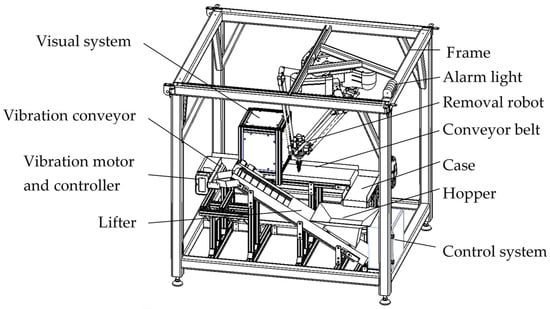
Figure 1.
Structure diagram of intelligent garlic-removal test bench.
The working process was as follows. All garlic cloves entered the hopper after the operation of the garlic peeling machine. Under the action of the lifter and the vibration conveyor, the garlic cloves were evenly and non-overlappingly distributed on the conveyor belt, and then the cloves moved at a uniform speed on the conveyor belt. After passing through the visual system, the garlic cloves that were not completely peeled would be identified, and their position information would be passed to the control system. Finally, the removal robot grabbed the target garlic cloves according to the position information and motion information of the target garlic cloves provided by the control system, and removed them.
The visual system was mainly composed of a CCD camera (SHL-300W, Shenzhen Shunhuali Electronics Co., Ltd., Shenzhen, China), an LED strip light source, and a dark box. It could collect images of garlic cloves on the conveyor belt in real time. The shooting speed was 10 fps, the CCD camera resolution was 2048 pixels × 1536 pixels, and the frame rate was 30 fps. The camera was vertically fixed at the center of the top of the black box, and the lens was 35 cm away from the conveyor belt plane. Two LED controllable light sources were fixed on the side of the dark box.
2.1.2. Visual System and Control System
The control system adopted a Lenovo Tianyi 510S split computer (Lenovo Group, Tianjin, China) with an Intel Core i5-12400 CPU model (Intel Corporation, Santa Clara, CA, USA), an 8 GB (DDR4, 3200 MHz) RAM model (Samsung Electronics Co., Ltd., Seoul, Republic of Korea), and a Lenovo motherboard model (Lenovo Group, Tianjin, China) plus an Intel B660 chipset (Intel Corporation, Santa Clara, CA, USA). The computer had the test bench control software installed and so on. The workflow of the control system is shown in Figure 2.
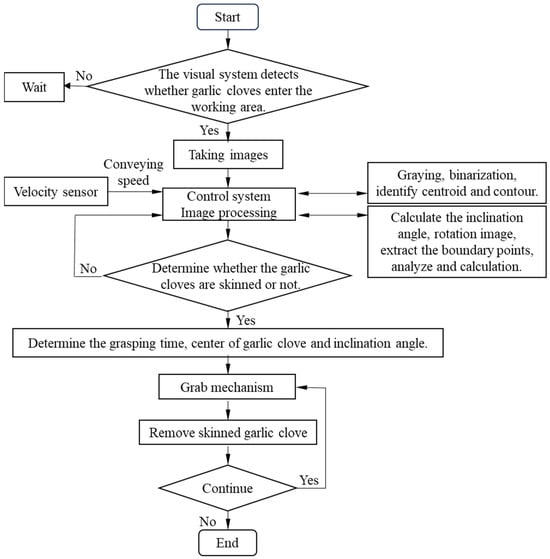
Figure 2.
The workflow of the control system.
Image processing mainly included gray processing, binarization processing, and identifying centroid and contour [], as shown in Figure 3. Each pixel of the image taken by the CCD camera was determined by the R, G, and B components, and each component could take 255 values. In this paper, the gray processing method of the weighted average method was used to assign different weights to the three components and calculate the weighted results. The following formula was obtained [].

Figure 3.
The main process of image processing.
In this formula, Gray was the weighted result. The original image is shown in Figure 3a, and after gray processing it is shown in Figure 3b.
Then, the brightness of the grayscale image was fine-tuned, and then binarized []. The processed image is shown in Figure 3c.
The centroid was identified according to the binary image information, as shown in Figure 3d. After marking the centroid, the inclination angle of each garlic clove was calculated. According to the order from left to right, the inclination angles of each garlic clove were 42.98°, 42.82°, −0.48°, −63.87°, 8.79°, −33.88°, −7.89°, −5.65°, −55.70°, and 88.31°.
Then, according to the centroid and inclination of the garlic clove, rotation of the image was carried out to return the inclination to zero, and the two endpoints of the garlic clove were obtained. As shown in Formula 1, firstly, by using the Moore-Neighbor Tracing Algorithm modified by Jacobi's Termination Criterion, the coordinates of the garlic boundary points were extracted from the left endpoint along the clockwise direction to the end of the right endpoint, forming the original upper boundary point set P1. Then, the coordinates of the garlic boundary points were extracted from the right endpoint along the clockwise direction to the end of the left endpoint, forming the original lower boundary point set P2. Count the number of points in P1 and P2, denoted by i and j, respectively. When i > j, the boundary points with larger y value in point P1 were eliminated, so that i = j. When i < j, the boundary points with smaller y value in point P2 were eliminated, so that i = j. Reorder P1 and P2 according to the abscissa from small to large, and calculate the difference of y value between each point in P1 and the corresponding point in P2 in turn to obtain point set P3. The formula was obtained. The points of 15 ≤ yk ≤ 35 in the statistical point set P3 were recorded as P4 due to the tip values of all garlic skins were in this range by data. When the number of points in P4 were more than 40, the garlic clove would be recognized as skinned garlic clove and marked with a red box. Otherwise, the garlic clove would be recognized as garlic clove without skin and marked with green box, as shown in Figure 3e.
Taking No.7 garlic clove as an example, the contour boundary processing result is shown in Figure 4.
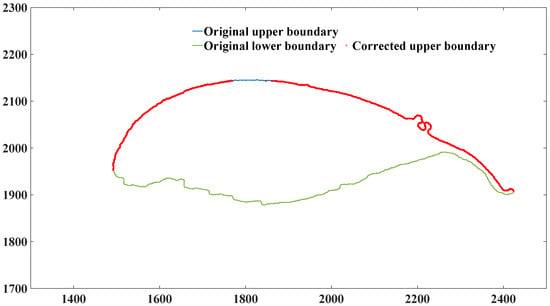
Figure 4.
The contour boundary processing result of No.7 garlic clove.
The whole algorithm is shown in Figure 5.
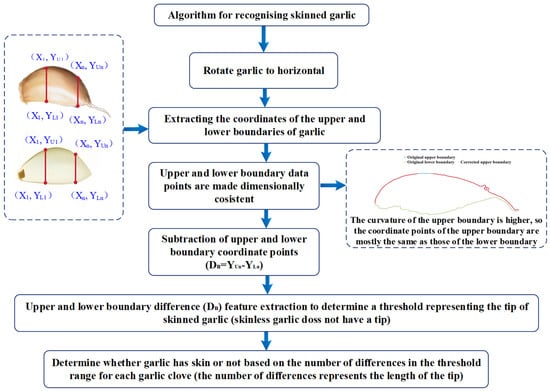
Figure 5.
Whole algorithm for recognizing skinned garlic cloves.
2.1.3. Removal Robot
The removal robot (Figure 6) was mainly composed of a motor, mechanical arm, pneumatic gripper, and frame. The specification of the frame was D3W-800-P3, which was previously purchased in Chenxing (Tianjin) Automation Equipment Co., Ltd. (Tianjin, China). The pneumatic gripper had four degrees of freedom, which were X, Y, and Z directions and Z-axis rotation. The EtherCAT protocol was used between the controller and the driver, so that the control system sent instructions to the motor during operation. The motor controlled the action of the mechanical arm, and adjusted the spatial movement and opening direction of the pneumatic gripper. The pneumatic gripper realized the clamping and loosening action under the control of the air compressor and the electromagnetic valve.
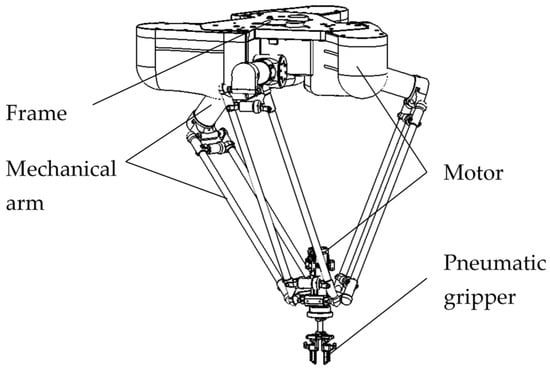
Figure 6.
Structure diagram of removal robot.
As shown in Figure 3, the claw arm of the pneumatic gripper had four tooth-shaped airbags, and under the action of air pressure the tooth-shaped airbag and the side wall of the gripper deformed due to different stress areas. When the pressure was positive, the gripper showed a curved shape of inward deformation to realize the clamping action.
According to the research of reference [] and experimental verification, the relationship between the elastic deformation T and the holding force FJ was roughly satisfied.
In this formula, Fj was the holding force, N, and T was the elastic deformation, mm.
The elastic deformation T could be roughly obtained by the distance Wg and the distance W.
In this formula, T was the elastic deformation, mm; Wg was the bottom distance of claw arm of the pneumatic gripper, mm; and W was the top distance of claw arm of the pneumatic gripper, mm.
The weight of the garlic cloves was generally 2~8 g, and the gravity was about 0.02~0.08 N. The relationship between the holding force of the claw arm and the elastic deformation and air pressure is shown in Figure 7. In general, when the air pressure of the claw was more than 40 kPa, the holding force of the claw arm exceeded 1 N, and under such conditions the garlic cloves could be stably grasped and moved.

Figure 7.
The schematic diagram of the pneumatic gripper and the relationship between the holding force of the claw arm and the elastic deformation and air pressure.
The process of removing skinned garlic cloves was as follows. The pneumatic gripper moved down from the initial position A and adjusted the opening orientation during the movement according to the information of the center of shape, inclination angle, and grasping time of the skinned garlic clove provided by the control system. After the target garlic clove was clipped, it was vertically moved up to the specified height, and then the moving direction was changed, horizontally moved to the position B directly above the placement point, and then the moving direction was changed to move down and release the garlic clove. Finally, the pneumatic gripper returned to the initial position A through position B, and adjusted the opening direction to the initial position. The whole removal operation of the skinned garlic clove could be recorded as a removal cycle. The schematic diagram of the removal cycle of the pneumatic gripper is shown in Figure 8 and the actuation strategy and control logic of the robotic arm is shown in Figure 9.

Figure 8.
Schematic diagram of the removal cycle of the pneumatic gripper.

Figure 9.
The actuation strategy and control logic of the robotic arm.
2.2. Test Materials and Methods
On 25 July 2024, researchers collected 50 kg of garlic clove samples after peeling-machine operations from some food factories in Jinxiang County, Shandong Province, China. The rate of skinned garlic cloves was about 5.6% in total. All skinned garlic cloves were collected by hand picking at first, and divided into 5 groups on average, in order to carry out tests of the success rates of machine vision and the removal robot.
In the test of the regression orthogonal, the Box–Behnken test method was used. Conveying speed, removal period, and conveying volume were taken as influencing factors. Each factor was set at three levels, coded as −1, 0, and 1, and the Box–Behnken test scheme is shown in Table 1. There were 17 groups with 5 replicates in each group. All garlic clove samples were fully mixed and divided into 5 groups on average. The test was carried out on 26–27 July in Jinan City, Shandong Province, China.

Table 1.
Factors and levels of Box–Behnken design.
The intelligent garlic-removal test bench (self-made) was used to carry out the test, as shown in Figure 10.
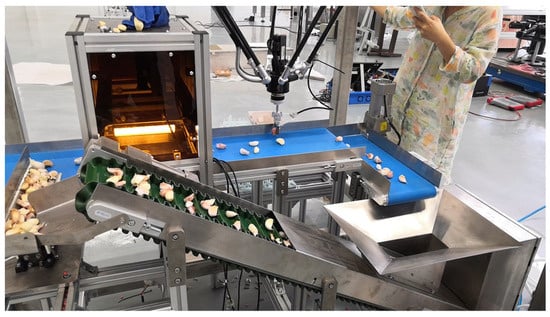
Figure 10.
The intelligent garlic-removal test bench.
2.2.1. Test of Success Rate of Machine Vision and Removal Robot
The success rate of machine vision and the removal robot can be obtained as follows.
In this formula, y1 was the success rate of machine vision, %; was the number of skinned garlic cloves recognized by machine vision; S1 was the total number of skinned garlic cloves in each group; y2 was the success rate of the removal robot, %; was the number of skinned garlic cloves garbed by the removal robot; and S2 was the total number of skinned garlic cloves which had been recognized in each group.
2.2.2. Test of Intelligent Garlic-Removal Test Bench
The removal rate of skinned garlic cloves in each group was selected as the test index. The following formula was obtained.
In this formula, y was the removal rate of skinned garlic cloves, %; Md was the total weight of skinned garlic cloves removed in each group, g; and M was the total weight of garlic cloves in each group, g.
3. Results and Discussion
3.1. Results of Success Rate and Error Rate of Machine Vision and Removal Robot
A large number of pre-test results showed that when the conveying speed was less than 0.3 m·s−1, the removal period was more than 1 s, and the conveying volume was less than 160 kg·h−1, the test bench could achieve a stable working state. When the pressure of the pneumatic gripper was between 40 kPa and 120 kPa, factors such as the pressure of the air, the size and shape of the garlic clove, and the weight of the garlic clove had little effect on the index, but the three factors of the conveying speed, the removal period, and the conveying volume had a greater impact on the index. Therefore, in the test of the success rate of machine vision and the removal robot, the conveying speed was 0.2 m·s−1, the removal period was 1.5 s, and the conveying volume was 120 kg·h−1. The results of the success rate of machine vision and the removal robot are shown in Table 2 and the results of error rate are shown in Table 3.

Table 2.
Results of success rate of machine vision and removal robot.

Table 3.
Results of error rate of designed machine vision and removal robot.
The results showed that the average success rate of machine vision was 99.15%, the average success rate of the removal robot was 99.13%, the average error rate of machine vision was 0.39%, and the average error rate of the removal robot was 0.16%.
3.2. Results of Regression Orthogonal Test
The results of regression orthogonal test are shown in Table 4.

Table 4.
Results of regression orthogonal test by Box–Behnken Design.
The variance analysis of the response surface quadratic model is shown in Table 5. Data showed that the regression model test of the removal rate (y) was extremely significant, and the lack of fit was not significant, which indicated that the test data were reliable. The regression terms X1, X2, an of the model had extremely significant effects on the removal rate. The order of importance of each test factor on the removal rate (y) was conveying speed (X1), conveying volume (X3), and removal period (X2).

Table 5.
Variance analysis of the response surface quadratic model.
For a conveying volume of 120 kg·h−1, the relationship between the removal rate (y), conveying speed (X1), and removal period (X2) is shown in Figure 11a. For a removal period of 1.5 s, the relationship between removal rate (y), conveying speed (X1), and conveying volume (X3) is shown in Figure 11b. For a conveying speed of 0.2 m·s−1, the relationship between removal rate (y), removal period (X2), and conveying volume (X3) is shown in Figure 11c.
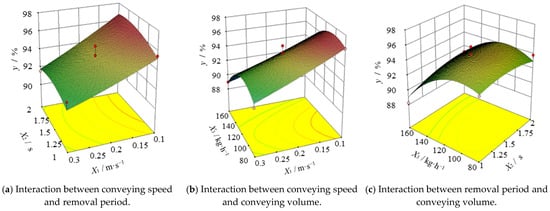
Figure 11.
The influence of the interaction between the factors on the removal rate (y).
Figure 11 shows that with the increase of conveying speed the removal rate increased, and with the increase of removal period and conveying volume the removal rate increased first and then decreased.
The quadratic regression equation between the removal rate (y) and all factors was as follows.
Excluding the insignificant items in the analysis of variance, the quadratic regression equation between the removal rate (y) and all factors was as follows.
Data from the response surface analysis indicated that the test data fit well. Taking the conveying speed, removal period, and conveying volume as independent variables, within the range of independent variables, the mathematical model formula was established with the removal rate as the target.
According to the Optimization module in Design Expert, the optimal parameter combination was a conveying speed of 0.1 m·s−1, a removal period of 1.725 s, and a conveying volume of 104.4 kg·h−1. The highest removal rate was 97.15%. The experimental verification was carried out under the conditions of this parameter combination, and the result was 97.02%, which had no significant different from the theoretical result, indicating that the model result was reliable.
3.3. Discussion
The results showed that the average success rate of machine vision was 99.15%, and the average success rate of the removal robot was 99.13%. The existing research is mainly focused on the tip orientation of garlic cloves. The author of reference [] measures the upper and lower ends of the garlic binary image, respectively. This study calculates the width of each row and accumulates it to determine the direction of the garlic cloves. If the garlic tip is upward, the growth rate of the width from bottom to top will be greater than from bottom to top. Through experimental demonstration, the number of garlic cloves in the correct direction accounted for 97% of the total number of tests. Some studies used the algorithm of tip recognition based on the contour features of garlic cloves. These algorithms need to extract the contour of garlic clove image, and identify the position or orientation of the garlic tip according to the curvature, sharp angle, number of pixels, and other single or multiple features of garlic tip contour. Reference [] proposes that the tip of the garlic clove exhibits the maximum curvature in the whole garlic image according to its morphological characteristics. Robles [] assumed that the minimum inner edge angle coincides with the apex of the bud tip. By calculating the minimum inner edge angle to locate the apex of the bud tip, the influence of the position and size of the apex on the correct recognition of the apex was evaluated. The boundary detection methods of Canny, Roberts, and Sobel were compared. The recognition rates of the three boundary detection methods were 91.25%, 77.5%, and 81.25%, respectively. Reference [] proposed a multi-feature algorithm to effectively identify the clove direction in images. The algorithm circles the minimum circumscribed rectangle on the binary image of the garlic, subtracts the binary image obtained by the opening operation from the original binary image to obtain the head area of the garlic clove, and takes the equal length area at both ends of the garlic and the contour image of the garlic. The three features of the edge length are extracted at the same height as the long axis of the contour image of the garlic, and the three features are fused according to the experiment to obtain the comprehensive features to determine the direction of the garlic clove. Experimental results showed that the adjustment rates of ‘Jinxiang’ and ‘Cangshan’ garlic were 94.6% and 97.5%, respectively. Compared with this technology, the automatic detection algorithm used in this paper is simpler and the recognition success rate is higher.
In practical applications, garlic cloves with skin or with mildew defects would be removed during manual operations. The visual system in this paper can only identify whether the garlic cloves are skinned, while Xiaopeng Li [] only studied the appearance defects of garlic cloves. The algorithm used in this manuscript has a higher accuracy and better effects under certain conditions, which reflects its innovation and advancement.
4. Conclusions
(1) In order to solve the problems of low production efficiency and high labor costs in removing skinned garlic cloves after peeling-machine operations, this paper designed an intelligent garlic-clove-removal test bench. A technical method based on machine vision technology to distinguish whether garlic cloves had skin was explored to ensure that the test bench could complete the identification of the skinned garlic cloves. Compared with reference [], the tests in this paper verified the working principle of a garlic-clove-removal test bench based on machine vision technology, which could improve the qualified rate of garlic cloves after the peeling operation and provide a reference for the optimization of garlic-clove-peeling machines.
(2) The regression orthogonal test was carried out by taking the conveying speed, the removal period, and the conveying volume as the factors and the removal rate of the skinned garlic cloves as the index. The results showed that the order of the three factors was the conveying speed, the conveying volume, and the removal period. When the conveying speed was 0.1 m·s−1, the grasping period was 1.725 s, and the conveying volume was 104.4 kg·h−1, the qualified rate of the finished product was 97.15%, and the verification test result was 97.02%, which had no significant difference from the analysis result.
(3) There are many varieties of garlic in Jinxiang County, Shandong Province, China, but the differences in the size and shape of garlic cloves were small. The garlic cloves taken in the tests were very representative in China, and more than 70% of garlic in China is of this kind of size and shape. The threshold values of the recognition algorithm applied in the manuscript can be adjusted. For other varieties of garlic, we can first observe a threshold range such as “yk” and “number of points in P4”, then adjust it to meet the recognition.
(4) In further studies, the visual system using edge extraction should not only judge whether the garlic cloves are skinned, but also judge whether the garlic cloves are mildewed. It is necessary to optimize and improve the removal robot by designing a multi-gripper mechanism to improve the success rate of clamping.
Author Contributions
Conceptualization, Z.Z. and Y.X.; methodology, Y.X. and L.X. (Li Xin); software, X.C. and L.X. (Lei Xin); formal analysis, Z.Z. and S.L.; investigation, L.X. (Li Xin) and S.L.; writing, Z.Z. and Y.X.; review and editing, X.C. and L.X. (Lei Xin); visualization, X.C. and L.X. (Lei Xin); funding acquisition, Z.Z. and L.X. (Li Xin). All authors have read and agreed to the published version of the manuscript.
Funding
National Natural Science Foundation of China (NSFC) (52005309). Jiangsu Postdoctoral Research Funding Program (2021K134B). Key R & D plan of Shandong Province (2024TZXD072, 2024TSGC0624 and 2024BTJH012). Technology Innovation Guidance Plan of Shandong Province (YDZX2024032).
Institutional Review Board Statement
Not applicable.
Data Availability Statement
The data presented in this study are available on request from the corresponding author. The data are not publicly available due to privacy.
Conflicts of Interest
Authors Li Xin, Lei Xin and Shuqian Li were employed by the company Shandong Maria Machinery Co., Ltd. The remaining authors declare that the research was conducted in the absence of any commercial or financial relationships that could be construed as a potential conflict of interest.
References
- Tao, Y.; Zhang, J.; Jiang, S.; Xu, Y.; Show, P.-L.; Han, Y.; Ye, X.; Ye, M. Contacting ultrasound enhanced hot-air convective drying of garlic slices: Mass transfer modeling and quality evaluation. J. Food Eng. 2018, 235, 79–88. [Google Scholar] [CrossRef]
- Thomas, A.; Boobyer, C.; Borgonha, Z.; van den Heuvel, E.; Appleton, K.M. Adding Flavours: Use of and Attitudes towards Sauces and Seasonings in a Sample of Community-Dwelling UK Older Adults. Foods 2021, 10, 2828. [Google Scholar] [CrossRef]
- Netzel, M.E. Garlic: Much More Than a Common Spice. Foods 2020, 9, 1544. [Google Scholar] [CrossRef]
- Furdak, P.; Pieńkowska, N.; Bartosz, G.; Sadowska-Bartosz, I. Extracts of Common Vegetables Inhibit the Growth of Ovary Cancer Cells. Foods 2022, 11, 2518. [Google Scholar] [CrossRef] [PubMed]
- Recinella, L.; Gorica, E.; Chiavaroli, A.; Fraschetti, C.; Filippi, A.; Cesa, S.; Cairone, F.; Martelli, A.; Calderone, V.; Veschi, S.; et al. Anti-Inflammatory and Antioxidant Effects Induced by Allium sativum, L. Extracts on an Ex Vivo Experimental Model of Ulcerative Colitis. Foods 2022, 11, 3559. [Google Scholar] [CrossRef]
- Phan, A.D.T.; Netzel, G.; Chhim, P.; Netzel, M.E.; Sultanbawa, Y. Phytochemical Characteristics and Antimicrobial Activity of Australian Grown Garlic (Allium sativum L.) Cultivars. Foods 2019, 8, 358. [Google Scholar] [CrossRef]
- Wang, J.; Zhang, X.; Lan, H.; Wang, W. Effect of garlic supplement in the management of type 2 diabetes mellitus (T2DM): A meta-analysis of randomized controlled trials. Food Nutr. Res. 2017, 61, 1377571. [Google Scholar] [CrossRef] [PubMed]
- Cui, Z.; Liu, X.; Chen, Y.; Guan, C.; Yang, Y.; Xu, B. Status, problems and countermeasures of whole mechanized production of garlic in China. J. Chin. Agric. Mech. 2023, 44, 239–243, 250. [Google Scholar]
- Crop Queries of Production Volume of Data [EB/OL]. Available online: https://www.fao.org/faostat/en/#data (accessed on 10 February 2024).
- Wang, J.; Li, Y.; Yang, X.; Wu, H.; Zhao, J.; Shen, Q. Research on the Processing Technology of Honeyed Garlic. China Condiment 2019, 44, 130–135. [Google Scholar]
- Hao, Q.; Gong, M.; Lu, X. Research Progress of Garlic Drying Technology. China Condiment 2020, 45, 193–195. [Google Scholar]
- Qian, X. Analysis on the Diversity of Related Agricultural Products Processing Types and Market Demand with Garlic as an Example. China Condiment 2020, 45, 192–194. [Google Scholar]
- Zhou, H.; Du, Z.; Wu, Z.; Song, C.; Guo, N.; Lin, Y. Application progress of machine vision technology in the field of modern agricultural equipment. J. Chin. Agric. Mech. 2017, 38, 86–92. [Google Scholar] [CrossRef]
- Guo, Y. Research of the Recognition Method of Garlic Direction in Planting Machinery. Ph.D. Thesis, Northwest Agriculture and Forestry Technology University, Xianyang, China, 2011; pp. 6–36. [Google Scholar]
- Guzmán, E.; Baeten, V.; Pierna, J.A.F.; García-Mesa, J.A. Infrared machine vision system for the automatic detection of olive fruit quality. Talanta 2013, 116, 894–898. [Google Scholar] [CrossRef]
- Liu, H.; Chahl, S.J. A multispectral machine vision system for invertebrate detection on green leaves. Comput. Electron. Agric. 2018, 150, 279–288. [Google Scholar] [CrossRef]
- Cardellicchio, A.; Solimani, F.; Dimauro, G.; Petrozza, A.; Summerer, S.; Cellini, F.; Renò, V. Detection of tomato plant phenotyping traits using YOLOv5-based single stage detectors. Comput. Electron. Agric. 2023, 207, 107757. [Google Scholar] [CrossRef]
- Afonso, M.; Fonteijn, H.; Fiorentin, F.S.; Lensink, D.; Mooij, M.; Faber, N.; Polder, G.; Wehrens, R. Tomato Fruit Detection and Counting in Greenhouses Using Deep Learning. Front. Plant Sci. 2020, 11, 571299. [Google Scholar] [CrossRef] [PubMed]
- Navasardyan, S.; Ohanyan, M. The Family of Onion Convolutions for Image Inpainting. Int. J. Comput. Vis. 2022, 130, 3070–3099. [Google Scholar] [CrossRef]
- Malekabadi, A.J.; Khojastehpour, M.; Emadi, B.; Golzarian, M.R. Development of a machine vision system for determination of mechanical properties of onions. Comput. Electron. Agric. 2017, 141, 131–139. [Google Scholar] [CrossRef]
- Kim, W.S.; Lee, D.H.; Kim, Y.J. Machine vision-based automatic disease symptom detection of onion downy mildew. Comput. Electron. Agric. 2020, 168, 105099. [Google Scholar] [CrossRef]
- Zhao, P.; Wang, Z.; Ding, P.; Wu, P.; Zang, C. Location Identification of Parallel Robot Based on Machine Vision. Manuf. Technol. Mach. Tool 2021, 12, 15–20. [Google Scholar]
- Luo, C.; Di, Z.; Xiang, Y.; Zhao, N.; Zhou, J.; Zhu, Z. Design and Experiment of Garlic Seed Recognition Clamping Test-bed Based on Machine Vision. J. Agric. Mech. Res. 2024, 46, 72–81. [Google Scholar]
- Lei, D.; Zheng, X. Design of Mechanical and Electrical Control System for Combined Harvester of Full Feeding Corn. J. Agric. Mech. Res. 2024, 46, 118–121+126. [Google Scholar]
- Li, C.; Gu, X.; Ren, H. A Cable-Driven Flexible Robotic Grasper With Lego-Like Modular and Reconfigurable Joints. IEEE/ASME Trans. Mechatron. 2017, 22, 2757–2767. [Google Scholar] [CrossRef]
- Ficur, P. A garlic clove direction detection based on pixel counting. In Proceedings of the 2014 1st Student Computer Science Research Conference, Berlin, Germany, 5–6 November 2014. [Google Scholar]
- Lei, P.; Shijian, D.; Ronghua, L. Research on the identification of the roots of garlic base on pattern recognition. J. Agric. Mech. Res. 2010, 32, 51–54. [Google Scholar]
- Saldaña-Robles, N.; Serwatowski Hlawinska, R.J.; Aguilera Hernández, R.A.; Saldaña-Robles, A.; Martínez-Jaime, O.A.; Gutiérrez-Vaca, C. Localización del ápice del ajo mediante técnicas de análisis digital de imagen. Agrociencia 2016, 50, 215–225. [Google Scholar]
- Li, Y.; Wu, Y.; Li, T.; Niu, Z.; Hou, J. Design and experiment of adjustment device based on machine vision for garlic clove direction. Comput. Electron. Agric. 2020, 174, 105513. [Google Scholar] [CrossRef]
- Li, X. Automatic Screening System for Appearance Defects of Garlic Clove Based on Machine Vision. Ph.D. Thesis, Tianjin University of Science and Technology, Tianjin, China, 2023; pp. 7–24. [Google Scholar]
Disclaimer/Publisher’s Note: The statements, opinions and data contained in all publications are solely those of the individual author(s) and contributor(s) and not of MDPI and/or the editor(s). MDPI and/or the editor(s) disclaim responsibility for any injury to people or property resulting from any ideas, methods, instructions or products referred to in the content. |
© 2025 by the authors. Licensee MDPI, Basel, Switzerland. This article is an open access article distributed under the terms and conditions of the Creative Commons Attribution (CC BY) license (https://creativecommons.org/licenses/by/4.0/).